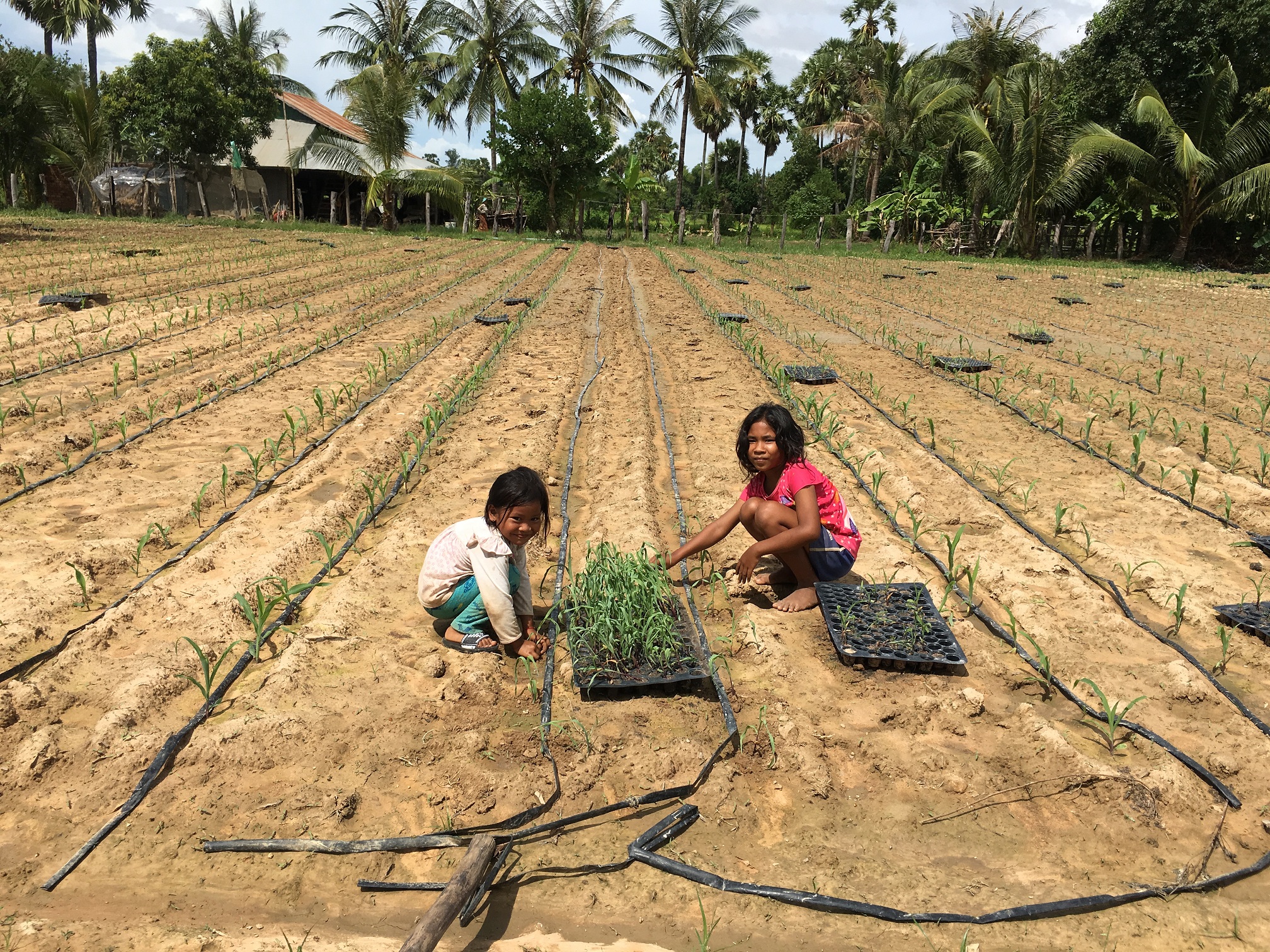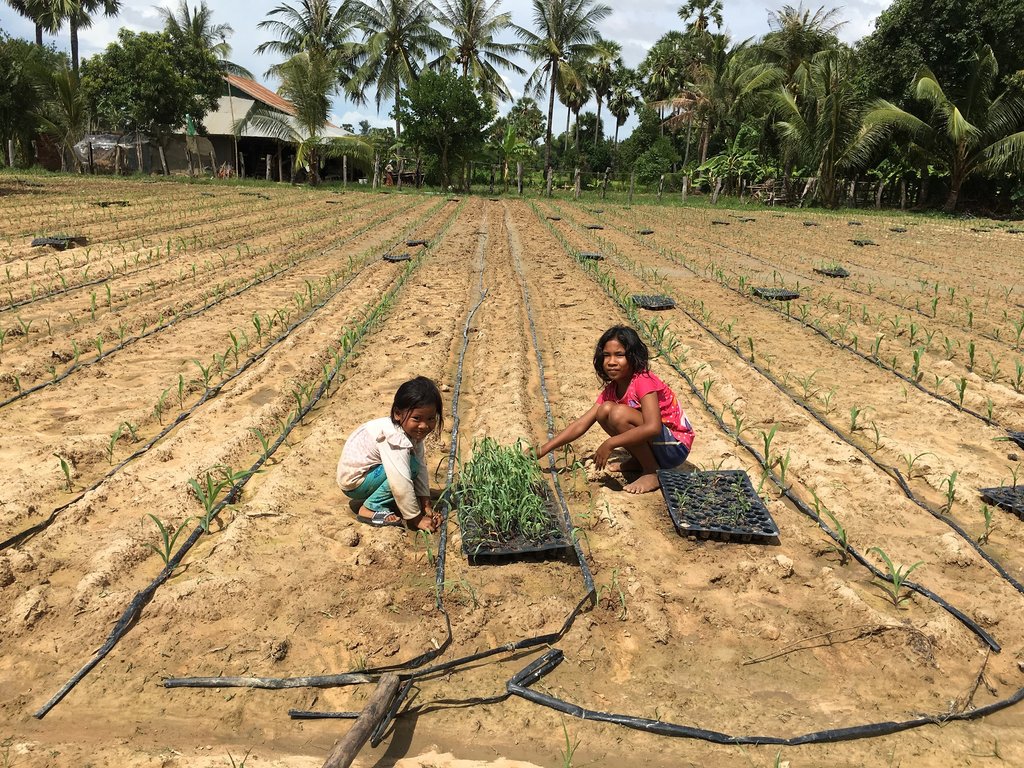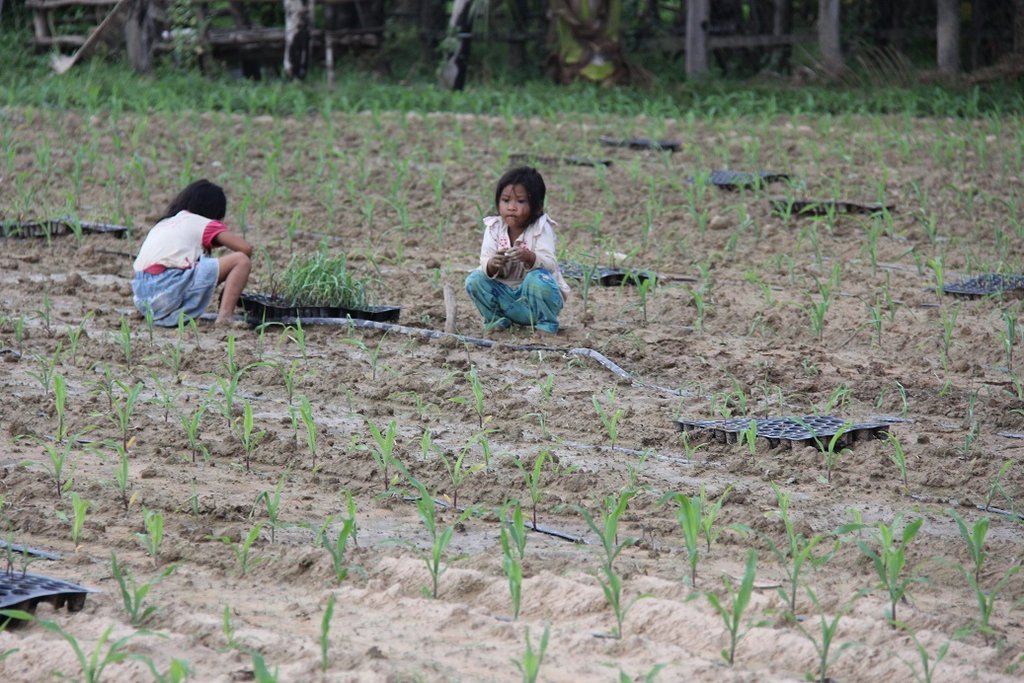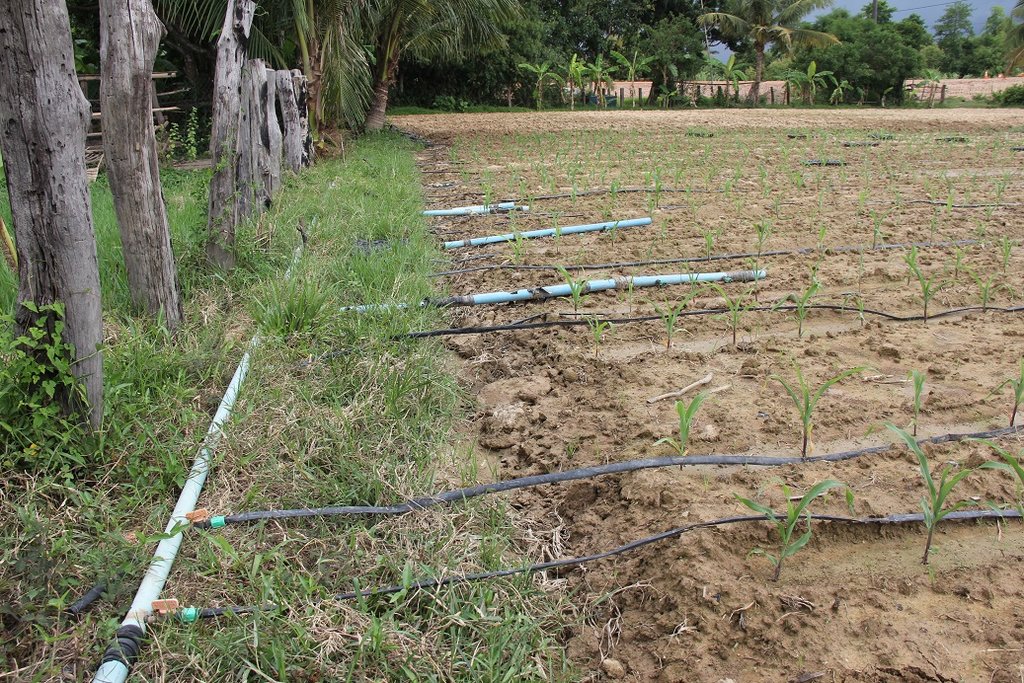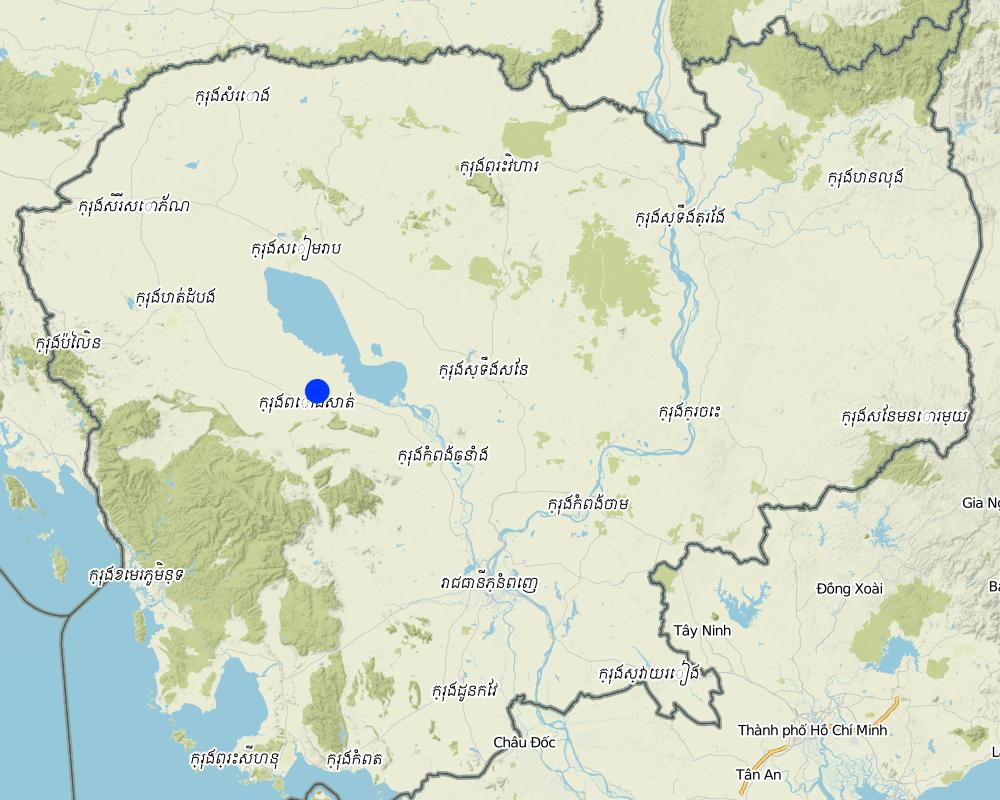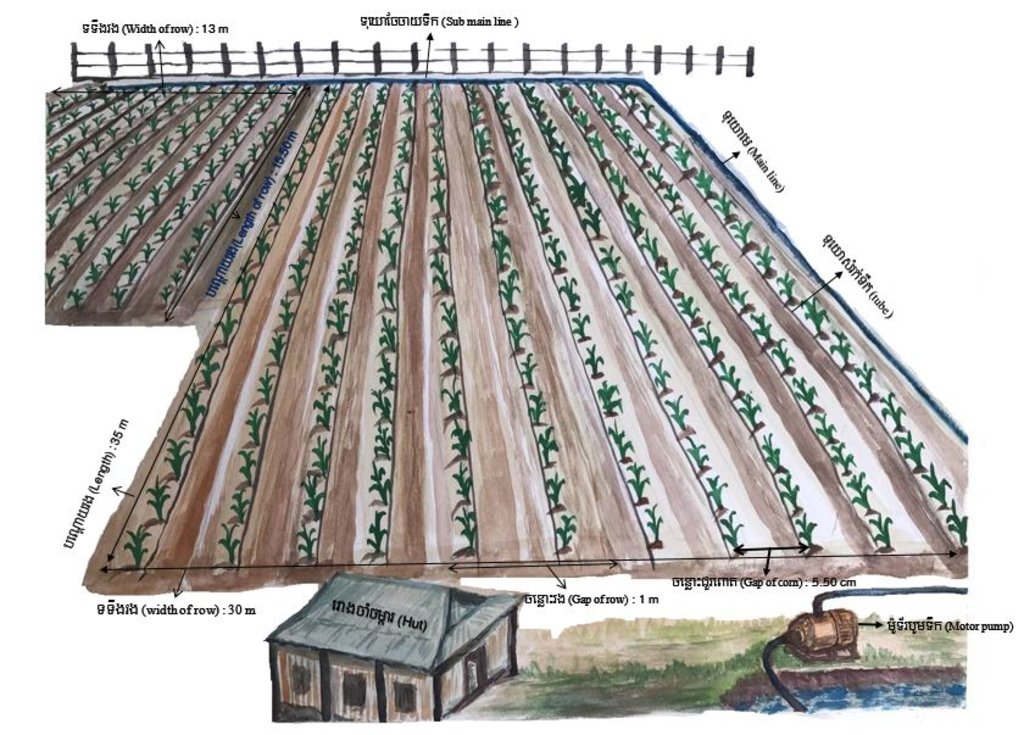ការដាំពោតដោយប្រើប្រព័ន្ធតំណក់ទឹក [Cambodia]
- Creation:
- Update:
- Compiler: Nary Lay
- Editors: Navin Chea, Sophea Tim
- Reviewers: SO Than, Alexandra Gavilano, Ursula Gaemperli
ការដាំពោតប្រើតំណក់ទឹក
technologies_3144 - Cambodia
View sections
Expand all Collapse all1. General information
1.2 Contact details of resource persons and institutions involved in the assessment and documentation of the Technology
Key resource person(s)
ប្រធានការិយាល័យផ្សព្វផ្សាយកសិកម្ម នៅមន្ទីរកសិកម្ម រុក្ខាប្រមាញ់ និងនេសាទ ខេត្តពោធិ៍សាត់:
ប្រធានការិយាល័យកសិកម្មស្រុកបាកាន:
មន្ត្រីក្សេត្រសាស្ត្រ នៅការិយាល័យកសិកម្មស្រុកកណ្តៀង:
សេង កម្ភៈ
(+855) 96 435 26 65
មិនមានអ៊ីម៉ែល
ការិយាល័យកសិកម្មស្រុកកណ្តៀង
ភូមិកណ្តៀង ឃុំកណ្តៀង ស្រុកកណ្តៀង ខេត្តពោធិ៍សាត់
Cambodia
ភ្នាក់ងារផ្សព្វផ្សាយ ឃុំកណ្តៀង:
ឈុន ឆេង
(+855) 77 93 10 01
មិនមានអ៊ីម៉ែល
ភ្នាក់ងារផ្សព្វផ្សាយ ឃុំកណ្តៀង
ភូមិស្ថានីយ៍ ឃុំកណ្តៀង ស្រុកកណ្តៀង ខេត្តពោធិ៍សាត់
Cambodia
land user:
ពេជ្រ ចន្ធី
(+855) 71 677 221
កសិករ
ភូមិកំពុងក្រសាំងក្រោម ឃុំកណ្តៀង ស្រុកកណ្តៀង ខេត្តពោធិ៍សាត់
Cambodia
Name of project which facilitated the documentation/ evaluation of the Technology (if relevant)
Scaling-up SLM practices by smallholder farmers (IFAD)Name of the institution(s) which facilitated the documentation/ evaluation of the Technology (if relevant)
Royal University of Agriculture (RUA) - Cambodia1.3 Conditions regarding the use of data documented through WOCAT
When were the data compiled (in the field)?
28/06/2017
The compiler and key resource person(s) accept the conditions regarding the use of data documented through WOCAT:
Ja
1.4 Declaration on sustainability of the described Technology
Is the Technology described here problematic with regard to land degradation, so that it cannot be declared a sustainable land management technology?
Nee
2. Description of the SLM Technology
2.1 Short description of the Technology
Definition of the Technology:
ការដាំពោតដោយប្រើប្រព័ន្ធតំណក់ទឹកជាបច្ចេកទេសដ៏មានប្រសិទ្ធភាពមួយក្នុងការសន្សំសំចៃទឹកដែលសមស្របសម្រាប់ស្រោចស្រពនៅទីណាដែលខ្សត់ទឹក។ កសិករបានប្រើប្រព័ន្ធតំណក់ទឹកនេះលើដំណាំពោតដោយវាអាចបន្ស៊ាំទៅនឹងការប្រែប្រួលអាកាសធាតុដូចជាភាពរាំងស្ងួតតាមរដូវកាល ឬពេលខ្សត់ភ្លៀង ដោយកាត់បន្ថយរំហួតមិនចាំបាច់ ចំណេញកម្លាំងពលកម្ម ពេលវេលា និងធ្វើឱ្យដំណាំលូតលាស់បានល្អ ទទួលបានទិន្នផលខ្ពស់ ដោយសារទទួលបានទឹកគ្រប់គ្រាន់។
2.2 Detailed description of the Technology
Description:
ការប្រើប្រាស់ប្រព័ន្ធតំណក់ទឹក គឺជាវិធីសាស្ត្រមួយដែលមានប្រសិទ្ធភាពខ្ពស់ក្នុងការសន្សំសំចៃទឹក ដោយការបន្តក់ទឹកជាតំណក់ៗ ជាទៀងទាត់តាមបណ្តាញបង្ហូរដល់គុម្ពដំណាំផ្ទាល់ (អត្រាបង្ហូរទឹក ៦ លីត្រ/ ម៉ោង និងសម្ពាធនៃរំហូរទឹក គឺចន្លោះពី ១,២-២ បារ(Bar))។ ប្រព័ន្ធតំណក់ទឹកជួយរក្សាសំណើមល្អបំផុតនៅជុំវិញគល់ដំណាំ (តំបន់ឫសដំណាំ) ហើយមិនផ្តល់សំណើមដល់តំបន់ដែលមិនចាំបាច់ដែលឆ្ងាយពីគល់ដំណាំទេ (John, 2018) ធ្វើដូច្នេះ គឺបានកាត់បន្ថយការដុះស្មៅចង្រៃយ៉ាងមានប្រសិទ្ធភាព លើសពីនេះ គឺអាចធានាក្នុងការផ្តល់ទឹកគ្រប់គ្រាន់សម្រាប់ដំណាំ ពិសេសក្នុងដំណាក់កាលចេញផ្កា ព្រោះកង្វះទឹកក្នុងដំណាក់កាលនេះអាចមានផលប៉ះពាល់យ៉ាងខ្លាំងដល់ទិន្នផលដំណាំ។ ការប្រើប្រព័ន្ធតំណក់ទឹកនេះកសិករអាចបន្ស៊ាំទៅនឹងការប្រែប្រួលអាកាសធាតុតាមរយៈការប្រើប្រាស់ទឹកយ៉ាងមានប្រសិទ្ធភាព ជាពិសេសតំបន់ដែលមានផលប៉ះពាល់ពីការប្រែប្រួលអាកាសធាតុដូចជាភាពរាំងស្ងួតតាមរដូវកាលជាដើម។ ម្យ៉ាងវិញទៀត ការប្រើប្រាស់ជីក៏អាចប្រើជាជីទឹកដាក់ផ្ទាល់តាមរយៈប្រព័ន្ធតំណក់ទឹកនេះផងដែរ។
ចំពោះការដាំពោតវិញ ដំបូងត្រូវយកជីលាមកគោមកបាចឱ្យពេញដី បន្ទាប់មកភ្ជួរដីលុប (ភ្ជួរបីសារ) រួចហាលដីរយៈពេល ៧ ថ្ងៃ បន្ទាប់មកត្រូវភ្ជួរ និងរាស់ដីឱ្យរាបស្អាត ទើបចាប់ផ្តើមពូនរង និងរៀបចំប្រព័ន្ធ តំណក់ទឹក។ បច្ចេកទេសនេះបានអនុវត្តនៅលើផ្ទៃដីទំហំ ២៣០១.៥ ម៉ែត្រការ៉េ។
ចំណែកឯការបណ្តុះកូនវិញ គឺកសិករយកដីដំបូក (ឬដីមានជីជាតិ ដីមមោក) ១ ភាគ ធ្យូងអង្កាម ២ ភាគ និងលាមកគោ ២ ភាគ មកលាយច្របល់ឱ្យសព្វ ទើបដាក់លើថាសបណ្តុះ និងយកគ្រាប់ពូជពោត ១ គ្រាប់ដាក់ក្នុងមួយរន្ធ។ ក្រោយពីពោតដុះបាន ១ សប្តាហ៍ហើយ ទើបយកទៅដាំ។ ការដាំកូនពោតកសិករយកឫស្សីទៅបុករណ្តៅជម្រៅ ៣ សង់ទីម៉ែត្រ រួចចាក់ទឹកជី (ដេ អា ប៉េ) ចូលក្នុងរណ្តៅ បន្ទាប់មកទើប យកកូនពោតទៅដាំ។ ការបណ្តុះកូនពោតជាមុននេះ គឺដើម្បីទទួលបានកូនពោតដែលដុះស្មើគ្នាល្អ មិនមានកូនអន់ កូនមិនងាយងាប់ ហើយពេលផ្លែមានគ្រាប់ពេញល្អ និងទទួលបានទិន្នផលខ្ពស់ជាងការដាំ ដោយដាក់គ្រាប់ដាំផ្ទាល់ ដែលតែងតែមានការដាំជួស (ដោយមានគ្រាប់ខ្លះមិនដុះ) ហើយកូនពោតដុះមិនស្មើគ្នាល្អដូចការបណ្តុះកូនដាំទេ។ ការដាំនេះផងដែរ កសិករដាំពោតជា ២ ជួរ ក្នុងមួយរង ចន្លោះពីជួរ មួយទៅជួរមួយទៀតមានប្រវែង ៥៥ សង់ទីម៉ែត្រ ហើយចន្លោះពីគុម្ពមួយទៅគុម្ពមួយទៀតមានប្រវែង ៣០ សង់ទីម៉ែត្រ។ គាត់ដាំពោត ២ ដងក្នុងមួយឆ្នាំ គឺនៅខែកក្កដា ដល់កញ្ញា និងកុម្ភៈ ដល់មេសា។
ចំពោះការស្រោចស្រពវិញ នៅរដូវវស្សាកសិករ ស្រោចទឹកតែនៅពេលណាដែលដីស្ងួត ដោយមិនមានភ្លៀងច្រើនថ្ងៃ ឬភ្លៀងមិនគ្រប់គ្រាន់ ដោយស្រោចតែក្នុងមួយថ្ងៃតែម្តងទេ អាចជាពេលព្រឹក ឬក៏ល្ងាច ដោយស្រោចម្តងៗគឺប្រើរយៈពេលប្រហែល ១០ ទៅ ១៥ នាទី។ ដោយឡែកនៅរដូវប្រាំងកសិករស្រោចពីរដងក្នុងមួយថ្ងៃ (ព្រឹក ល្ងាច) ដោយប្រើរយៈពេលប្រហែលជា ៣០ នាទីក្នុងការស្រោចម្តងៗ។ សម្រាប់ រដូវប្រាំងការប្រើប្រាស់ទឹកសម្រាប់ស្រោចពោតមួយថ្ងៃអស់ ៦ ទៅ ៧ លីត្រ ដោយអាត្រារំហូរទឹករបស់ប្រព័ន្ធតំណក់ ៦ លីត្រក្នុងមួយម៉ោង។ ប្រព័ន្ធតំណក់ទឹកនេះអាចមានរំហូរទឹកចន្លោះពី ១ ទៅ ៤ ហ្គាឡុនក្នុងមួយម៉ោង (១ ហ្គាឡុន = ៣.៧៨៥ លីត្រ) ប្រែប្រួលតាមសម្ពាធទឹក។
ចំពោះការចំណាយទៅលើប្រព័ន្ធតំណក់ទឹកគឺ គម្រោងហាវែសជាអ្នកចំណាយឱ្យកសិករក្នុងឆ្នាំ ២០១៤ ដូច្នេះកសិករចំណាយទៅលើតែការរៀបចំដី ការទិញគ្រាប់ពូជ ទិញធាតុចូលកសិកម្ម និងការថែទាំ ប៉ុណ្ណោះ។ បើគិតពីការប្រើប្រាស់ទឹកវិញក្នុងមួយរដូវដាំដុះ (រដូវប្រាំង) លើផ្ទៃដីដូចខាងលើគាត់ប្រើប្រាស់ទឹកអស់ជាមធ្យមពី ៦០០ ទៅ ៧០០ ម៉ែត្រគីបប៉ុណ្ណាះ ដែលទឹកនេះ គឺមានប្រភពពីទឹកស្រះ និងទឹកស្ទឹង។
ការប្រើប្រាស់ប្រព័ន្ធតំណក់ទឹកនេះជួយកាត់បន្ថយកម្លាំងពលកម្មសម្រាប់ការស្រោចស្រព សន្សំសំចៃពេលវេលា អាចរក្សាដំណាំដុះលូតលាស់បានល្អនៅពេលមិនសម្បូរទឹក សន្សំសំចៃទឹក និងជួយកាត់បន្ថយ ការដុះស្មៅនៅចន្លោះកូនដំណាំផងដែរ។ ដូចនេះប្រព័ន្ធតំណក់ទឹក គឺសមស្របបំផុតសម្រាប់ការស្រោចស្រពដើម្បីឆ្លើយតបទៅនឹងការប្រែប្រួលអាកាសធាតុ ដូចជាគ្រោះរាំងស្ងួតតាមរដូវកាល ជាពិសេស តំបន់ខ្សត់ទឹក។
2.3 Photos of the Technology
2.5 Country/ region/ locations where the Technology has been applied and which are covered by this assessment
Country:
Cambodia
Region/ State/ Province:
ភូមិកំពង់ក្រសាំងក្រោម ឃុំកណ្តៀង ស្រុកកណ្តៀង ខេត្តពោធិ៍សាត់
Further specification of location:
ចម្ការនៅក្បែរភូមិ
Map
×2.6 Date of implementation
Indicate year of implementation:
2014
2.7 Introduction of the Technology
Specify how the Technology was introduced:
- through projects/ external interventions
Comments (type of project, etc.):
គម្រោងហាវែស (Harvest) និងធ្វើតាមគេ។
3. Classification of the SLM Technology
3.1 Main purpose(s) of the Technology
- improve production
- adapt to climate change/ extremes and its impacts
- create beneficial economic impact
- កាត់បន្ថយការប្រើប្រាស់ទឹក និងកម្លាំងពលកម្ម
3.2 Current land use type(s) where the Technology is applied

Cropland
- Annual cropping
Main crops (cash and food crops):
ពោត
If land use has changed due to the implementation of the Technology, indicate land use before implementation of the Technology:
ពីមុនជាដីស្រែតែក្រោយមកប្តូរជាដីចម្ការប្រហែលជា ៣ ឆ្នាំហើយ។
3.3 Further information about land use
Water supply for the land on which the Technology is applied:
- mixed rainfed-irrigated
Comments:
ប្រភពទឹកបានមកពីស្ទឹងពោធិ៍សាត់ដែលនៅក្បែរទីតាំងអនុវត្តន៍នោះ។
Number of growing seasons per year:
- 3
Specify:
ដាំបន្តគ្នាពេញ ១ ឆ្នាំ
Livestock density (if relevant):
ចិញ្ចឹមគោ ៥ ក្បាល
3.4 SLM group to which the Technology belongs
- rotational systems (crop rotation, fallows, shifting cultivation)
- integrated soil fertility management
- irrigation management (incl. water supply, drainage)
3.5 Spread of the Technology
Specify the spread of the Technology:
- applied at specific points/ concentrated on a small area
3.6 SLM measures comprising the Technology

agronomic measures
- A1: Vegetation/ soil cover
- A2: Organic matter/ soil fertility

structural measures
- S7: Water harvesting/ supply/ irrigation equipment
3.7 Main types of land degradation addressed by the Technology

chemical soil deterioration
- Cn: fertility decline and reduced organic matter content (not caused by erosion)

physical soil deterioration
- Pc: compaction
- Pu: loss of bio-productive function due to other activities

biological degradation
- Bc: reduction of vegetation cover

water degradation
- Ha: aridification
3.8 Prevention, reduction, or restoration of land degradation
Specify the goal of the Technology with regard to land degradation:
- prevent land degradation
- reduce land degradation
4. Technical specifications, implementation activities, inputs, and costs
4.1 Technical drawing of the Technology
4.2 Technical specifications/ explanations of technical drawing
សមាសធាតុផ្សំនៃប្រព័ន្ធតំណក់ទឹករួមមាន ម៉ូទ័របូមទឹក សន្ទះបិទបើក (ក្បាលរ៉ូប៊ីនេ) តំរងច្រោះ នាឡិកាវាស់សម្ពាធ ទុយោមេ (មុខកាត់ ៦០ មីលីម៉ែត្រ) ទុយោខ្នែង(មុខកាត់ ៤៩ មីលីម៉ែត្រ) និងទុយោសម្រក់ទឹក (មុខកាត់ ១៦ មីលីម៉ែត្រ)។ ប្រព័ន្ធតំណក់ទឹកនេះត្រូវបានអនុវត្តលើផ្ទៃដីទំហំ ២៣០១.៥ ម៉ែត្រការ៉េ។
ចំពោះការរៀបចំធ្វើរងមាន ២ របៀបអាស្រ័យលើរដូវកាល គឺនៅរដូវវស្សាកសិករត្រូវភ្ជួរផ្គុំជារងដែលមានកម្ពស់រង ៥០ សង់ទីម៉ែត្រ ទទឹងរង ១ ម៉ែត្រ ចន្លោះរង ១ ម៉ែត្រ ហើយបណ្តោយរងនីមួយៗ គឺតាមប្រវែងដីជាក់ស្តែង។
ចំពោះរដូវប្រាំងវិញ កសិករភ្ជួរផ្គុំជារងដូចគ្នាតែកម្ពស់រងទាបជាងគឺមានកម្ពស់តែ ២០ សង់ទីម៉ែត្រប៉ុណ្ណោះដោយសាររដូវប្រាំងមិនមានភ្លៀងខ្លាំងដែលធ្វើឱ្យដីជាំទឹក។ ក្នុងមួយជួរមានទុយោសម្រក់ទឹកមួយ។
4.3 General information regarding the calculation of inputs and costs
Specify how costs and inputs were calculated:
- per Technology area
Indicate size and area unit:
២៣០១.៥ ម៉ែត្រការ៉េ
other/ national currency (specify):
រៀល
Indicate exchange rate from USD to local currency (if relevant): 1 USD =:
4000.0
Indicate average wage cost of hired labour per day:
២០០០០
4.4 Establishment activities
| Activity | Type of measure | Timing | |
|---|---|---|---|
| 1. | ភ្ជួរដីហាល | Agronomic | ខែឧសភា |
| 2. | ឆូតរង + បណ្តុះកូន + រៀបទុយោដំណក់ទឹក | Agronomic | ខែមិថុនា |
| 3. | បុករណ្តៅ + ដាក់ជី+ដាំកូន | Agronomic | ខែមិថុនា |
4.5 Costs and inputs needed for establishment
| Specify input | Unit | Quantity | Costs per Unit | Total costs per input | % of costs borne by land users | |
|---|---|---|---|---|---|---|
| Labour | ភ្ជួរដី | នាក់-ថ្ងៃ | 4.7 | 20000.0 | 94000.0 | 100.0 |
| Labour | ឆូតរង និងរៀបទុយោដំណក់ទឹក | នាក់-ថ្ងៃ | 2.5 | 20000.0 | 50000.0 | 100.0 |
| Labour | ការបណ្តុះកូន និងដាំកូនពោត | នាក់-ថ្ងៃ | 4.0 | 20000.0 | 80000.0 | 100.0 |
| Equipment | ម៉ូទ័របូមទឹក | គ្រឿង | 1.0 | 240000.0 | 240000.0 | 100.0 |
| Equipment | ចប | ចប | 1.0 | 200000.0 | 200000.0 | 30.0 |
| Equipment | ថាសបណ្តុះ | ថាស | 80.0 | 2500.0 | 200000.0 | 100.0 |
| Plant material | គ្រាប់ពោត | កញ្ចប់ | 3.0 | 28000.0 | 84000.0 | 100.0 |
| Fertilizers and biocides | ជី (D A P កាលី អ៊ុយរ៉េ) | គីឡូក្រាម | 7.0 | 2000.0 | 14000.0 | 100.0 |
| Construction material | ទុយោ | ម៉ែត្រ | 100.0 | 1600.0 | 160000.0 | 100.0 |
| Construction material | ទុយោតំណក់ទឹក | ដុំ | 1.0 | 200000.0 | 200000.0 | 30.0 |
| Total costs for establishment of the Technology | 1322000.0 | |||||
If land user bore less than 100% of costs, indicate who covered the remaining costs:
គម្រោងហាវែស (Harvest) ជួយទុយោតំណក់ទឹក
4.6 Maintenance/ recurrent activities
| Activity | Type of measure | Timing/ frequency | |
|---|---|---|---|
| 1. | ស្រោចទឹកពេលអត់ភ្លៀងដោយប្រើប្រព័ន្ធតំណក់ទឹក | Agronomic | ខែរាំង |
| 2. | ដាក់ជី ៤ ដងក្នុង ១ វដ្តដំណាំ | Agronomic | ពេលថែទាំ |
| 3. | ពូនរងក្រោយពេលដាំបាន ១៥ ថ្ងៃ ឬ ១៨ ថ្ងៃ | Agronomic | ពេលថែទាំ |
| 4. | លះស្លឹកពោត ២ ដង៖ អាយុ ២០ ថ្ងៃ និង ១ខែ | Agronomic | ពេលថែទាំ |
4.7 Costs and inputs needed for maintenance/ recurrent activities (per year)
| Specify input | Unit | Quantity | Costs per Unit | Total costs per input | % of costs borne by land users | |
|---|---|---|---|---|---|---|
| Labour | ពូនរង | នាក់-ថ្ងៃ | 1.0 | 20000.0 | 20000.0 | 100.0 |
| Labour | លះស្លឹកពោត | នាក់-ថ្ងៃ | 1.0 | 20000.0 | 20000.0 | 100.0 |
| Fertilizers and biocides | ជី | គីឡួក្រាម | 40.0 | 2000.0 | 80000.0 | 100.0 |
| Other | អគ្គិសនីសម្រាប់បូមទឹក | គីឡូវ៉ាត់-ម៉ោង | 267.0 | 790.0 | 210930.0 | 100.0 |
| Total costs for maintenance of the Technology | 330930.0 | |||||
4.8 Most important factors affecting the costs
Describe the most determinate factors affecting the costs:
គ្រាប់ពូជ និងទុយោតំណក់ទឹកមានតម្លៃថ្លៃ។
5. Natural and human environment
5.1 Climate
Annual rainfall
- < 250 mm
- 251-500 mm
- 501-750 mm
- 751-1,000 mm
- 1,001-1,500 mm
- 1,501-2,000 mm
- 2,001-3,000 mm
- 3,001-4,000 mm
- > 4,000 mm
Specify average annual rainfall (if known), in mm:
1225.70
Specifications/ comments on rainfall:
បរិមាណទឹកភ្លៀងប្រចាំឆ្នាំ 2015 មាន 1225.7 មីលីម៉ែត្រ ឆ្នាំ 2014 មាន 1128.1 និងឆ្នាំ 2013 មាន 1316 មីលីម៉ែត្រ
Indicate the name of the reference meteorological station considered:
ក្រសួងធនធានទឹក និង ឧត្តុនិយម (២០១៥)
Agro-climatic zone
- sub-humid
អាកាសធាតុក្តៅហើយសើម និងមានពីរដូវ៖ រដូវប្រាំង និងរដូវវស្សា។
5.2 Topography
Slopes on average:
- flat (0-2%)
- gentle (3-5%)
- moderate (6-10%)
- rolling (11-15%)
- hilly (16-30%)
- steep (31-60%)
- very steep (>60%)
Landforms:
- plateau/plains
- ridges
- mountain slopes
- hill slopes
- footslopes
- valley floors
Altitudinal zone:
- 0-100 m a.s.l.
- 101-500 m a.s.l.
- 501-1,000 m a.s.l.
- 1,001-1,500 m a.s.l.
- 1,501-2,000 m a.s.l.
- 2,001-2,500 m a.s.l.
- 2,501-3,000 m a.s.l.
- 3,001-4,000 m a.s.l.
- > 4,000 m a.s.l.
Indicate if the Technology is specifically applied in:
- not relevant
5.3 Soils
Soil depth on average:
- very shallow (0-20 cm)
- shallow (21-50 cm)
- moderately deep (51-80 cm)
- deep (81-120 cm)
- very deep (> 120 cm)
Soil texture (topsoil):
- medium (loamy, silty)
Soil texture (> 20 cm below surface):
- medium (loamy, silty)
Topsoil organic matter:
- medium (1-3%)
If available, attach full soil description or specify the available information, e.g. soil type, soil PH/ acidity, Cation Exchange Capacity, nitrogen, salinity etc.
pH = 5.5
5.4 Water availability and quality
Ground water table:
5-50 m
Availability of surface water:
good
Water quality (untreated):
good drinking water
Is water salinity a problem?
Nee
Is flooding of the area occurring?
Ja
Regularity:
episodically
5.5 Biodiversity
Species diversity:
- low
Habitat diversity:
- low
5.6 Characteristics of land users applying the Technology
Sedentary or nomadic:
- Sedentary
Market orientation of production system:
- commercial/ market
Off-farm income:
- 10-50% of all income
Relative level of wealth:
- average
Individuals or groups:
- individual/ household
Level of mechanization:
- manual work
- mechanized/ motorized
Gender:
- women
Age of land users:
- middle-aged
Indicate other relevant characteristics of the land users:
កសិករអាយុ ៤៧ ឆ្នាំ
5.7 Average area of land owned or leased by land users applying the Technology
- < 0.5 ha
- 0.5-1 ha
- 1-2 ha
- 2-5 ha
- 5-15 ha
- 15-50 ha
- 50-100 ha
- 100-500 ha
- 500-1,000 ha
- 1,000-10,000 ha
- > 10,000 ha
Is this considered small-, medium- or large-scale (referring to local context)?
- medium-scale
Comments:
ដីដំាដំណាំ ០.៥ ហិកតា ដីស្រែ ៣ ហិកតា ហើយធ្វើជាប់លាប់ ១ ហិកតា និងជួលឱ្យអ្នកជិតខាង ២ ហិកតា។
5.8 Land ownership, land use rights, and water use rights
Land ownership:
- individual, titled
Land use rights:
- individual
Water use rights:
- open access (unorganized)
5.9 Access to services and infrastructure
health:
- poor
- moderate
- good
education:
- poor
- moderate
- good
technical assistance:
- poor
- moderate
- good
employment (e.g. off-farm):
- poor
- moderate
- good
markets:
- poor
- moderate
- good
energy:
- poor
- moderate
- good
roads and transport:
- poor
- moderate
- good
drinking water and sanitation:
- poor
- moderate
- good
financial services:
- poor
- moderate
- good
6. Impacts and concluding statements
6.1 On-site impacts the Technology has shown
Socio-economic impacts
Production
crop production
Quantity before SLM:
30%
Quantity after SLM:
80%
Comments/ specify:
តាមរយៈការប្រើប្រព័ន្ធតំណក់ទឹក គាត់អាចដាំបានពីរ ឬបីដងក្នុងមួយឆ្នាំ។
crop quality
Comments/ specify:
ប្រើប្រាស់ជីលាមកគោ និងមានទឹកគ្រប់គ្រាន់។
risk of production failure
Comments/ specify:
ការបណ្តុះកូនមុនដាំ គឺធ្វើឱ្យកូនដុះបានល្អ និងមិនងាប់នៅពេលដាំ។
land management
Comments/ specify:
ដីមានជីជាតិល្អជាងមុនដោយសារតែប្រើប្រាស់លាមកគោ មានដំណាំជាគម្រប់ដីអាចរក្សាសំណើមដីបានល្អ។
Income and costs
expenses on agricultural inputs
Comments/ specify:
កាត់បន្ថយការចំណាយទៅលើការប្រើប្រាស់ជីគីមី និងកម្លាំងពលកម្ម។
farm income
Comments/ specify:
ដោយសារការដាំពោតដាំបានពីរដងក្នុងមួយឆ្នាំ និងទទួលបានទិន្នផលខ្ពស់។
workload
Comments/ specify:
មិនត្រូវការកម្លាំងពលកម្មច្រើនទៅលើការស្រោចស្រព និងថែទាំ។
Socio-cultural impacts
food security/ self-sufficiency
Comments/ specify:
អាចដាំដំណាំបានពីរ ឬបីដងក្នុងមួយឆ្នាំ និងទទួលបានទិន្នផលច្រើន។
health situation
Comments/ specify:
មិនមានប៉ះពាល់ដល់សុខភាពទេព្រោះមិនមានប្រើប្រាស់ជីគីមីច្រើន។
SLM/ land degradation knowledge
Comments/ specify:
ចេះបណ្តុះកូនមុនពេលដាំ ការប្រើប្រាស់ប្រព័ន្ធតំណក់ទឹកអាចជួយសន្សំសំចៃទឹកក្នុងការស្រោចស្រពដំណាំ។
Ecological impacts
Water cycle/ runoff
evaporation
Comments/ specify:
មានដំណាំជាគម្របដីកាត់បន្ថយរំហួត និងអាចរក្សាសំណើមបានល្អ។
Soil
soil moisture
Comments/ specify:
ដំណាំរក្សាសំណើមដីបានល្អ។
soil compaction
Comments/ specify:
ការប្រើប្រាស់ជីលាមកគោជួយឱ្យដីធូរ និងដំណាំជួយរក្សាសំណើមដីដោយសារតែដីទទួលបានទឹកជាប្រចាំពីប្រព័ន្ធតំណក់ទឹក។
soil organic matter/ below ground C
Comments/ specify:
ការប្រើប្រាស់លាមកគោ និងកាកសំណល់ដំណាំជួយបង្កើនសារធាតុចិញ្ចឹមដល់ដី។
6.2 Off-site impacts the Technology has shown
Comments regarding impact assessment:
មិនមានប៉ះពាល់ទៅដល់បរិវេណខាងក្រៅបច្ចេកទេសទេ
6.3 Exposure and sensitivity of the Technology to gradual climate change and climate-related extremes/ disasters (as perceived by land users)
Gradual climate change
Gradual climate change
| Season | Type of climatic change/ extreme | How does the Technology cope with it? | |
|---|---|---|---|
| annual temperature | increase | very well | |
| annual rainfall | increase | moderately |
Climate-related extremes (disasters)
Climatological disasters
| How does the Technology cope with it? | |
|---|---|
| drought | very well |
6.4 Cost-benefit analysis
How do the benefits compare with the establishment costs (from land users’ perspective)?
Short-term returns:
slightly positive
Long-term returns:
positive
How do the benefits compare with the maintenance/ recurrent costs (from land users' perspective)?
Short-term returns:
positive
Long-term returns:
positive
6.5 Adoption of the Technology
- 1-10%
If available, quantify (no. of households and/ or area covered):
4 គ្រួសារ
Of all those who have adopted the Technology, how many have did so spontaneously, i.e. without receiving any material incentives/ payments?
- 0-10%
6.6 Adaptation
Has the Technology been modified recently to adapt to changing conditions?
Nee
6.7 Strengths/ advantages/ opportunities of the Technology
| Strengths/ advantages/ opportunities in the land user’s view |
|---|
| កាត់បន្ថយកម្លាំងពលកម្មក្នុងការស្រោចដំណាំ។ |
| ទទួលទិន្នផលច្រើន។ |
| Strengths/ advantages/ opportunities in the compiler’s or other key resource person’s view |
|---|
| ការបណ្តុះកូនក្នុងថាសបណ្តុះ គឺប្រើដីតិច និងកូនដុះស្មើរគ្នាល្អពេលដាំនៅចម្ការកូនមិនអន់។ |
| ចំណេញពេលវេលា និងប្រើប្រាស់ទឹកតិច។ |
| មិនសូវដុះស្មៅ និងមានពពួកមីក្រូសារពាង្គកាយក្នុងដីច្រើន និងទទួលបានផលច្រើន។ |
6.8 Weaknesses/ disadvantages/ risks of the Technology and ways of overcoming them
| Weaknesses/ disadvantages/ risks in the land user’s view | How can they be overcome? |
|---|---|
| ចំណាយពេលវេលាសារទុយោតំណក់ទឹកទុកក្រោយពេលប្រមូលផលដំណាំរួច។ | ដើរប្រមូលទុយោតំណក់ទឹក។ |
| មានតម្លៃថ្លៃ | កសិករត្រូវចេះថែរក្សា និងតទុយោតំណក់ទឹកដោយខ្លួនឯងពេលខូច លាងវាឱ្យស្អាត និងទុកដាក់ឱ្យបានត្រឹមត្រូវ។ |
| សំណល់ទុយោមិនអាចធ្វើអ្វីបាន។ | ដុត ឬកប់ក្នុងដី |
7. References and links
7.1 Methods/ sources of information
- field visits, field surveys
១កន្លែង
- interviews with land users
១ នាក់
- interviews with SLM specialists/ experts
៤ នាក់
7.3 Links to relevant information which is available online
Title/ description:
John D. (2018). Corn benefits of Drip Irrigation. John Deere water. Retrieved from
URL:
https://www.deere.com/en_US/docs/agriculture/irrigation_and_water_management/brochure_irrigation_solutions_corn.pdf
Title/ description:
DanChurchAid/Christian Aid. (2015). Farmer book: Kit of best Agriculture Technologies to Adapt with climate change. Ministry of Agriculture, Forestry and Finsheries. In Khmer. Retrieved from
URL:
http://www.maff.gov.kh/agri-tech/78-%E1%9E%80%E1%9E%B6%E1%9E%9A%E1%9E%8A%E1%9E%B6%E1%9F%86%E1%9E%8A%E1%9E%BB%E1%9F%87%E1%9E%8A%E1%9F%86%E1%9E%8E%E1%9E%B6%E1%9F%86/%E1%9E%80%E1%9E%B6%E1%9E%9A%E1%9E%8A%E1%9E%B6%E1%9F%86%E1%9E%8A%E1%9E%BB%E1%9F%87%E1%9E%8A%E1%9F%86%E1%9E%8E%E1%9E%B6%E1%9F%86%E1%9E%95%E1%9F%92%E1%9E%9F%E1%9F%81%E1%9E%84%E1%9F%97%E1%9E%91%E1%9F%80%E1%9E%8F/1586-variety-agriculture.html
Title/ description:
Maff (2014 August). Technical growing corn. Agricultural magazin.volum(47). In Khmer. Retrieve from
URL:
www.maff.gov.kh/agri-tech/40.../1161-technical growing corn.html
Title/ description:
Agritoday (2018). Corn planting technique. Ministry of Agriculture, Forestry and Fisheries. In Khmer. Retrieved from
URL:
http://agritoday.com/view/1593.html
Title/ description:
Cam Agriculture (2016). The modern irrigation system. CAM AGRICULTURE IMPORT EXPORT LTD. In Khmer. Retrieved from
URL:
http://www.camagriculture.com/drip-irrigation-system/?lang=kh
Links and modules
Expand all Collapse allLinks
No links
Modules
No modules


